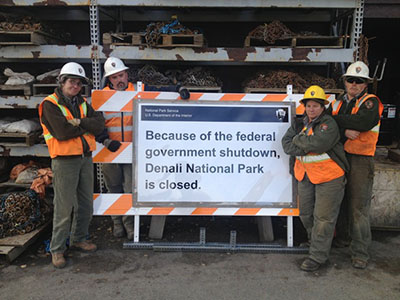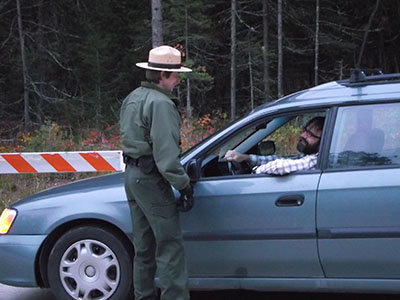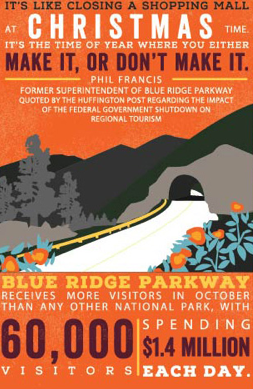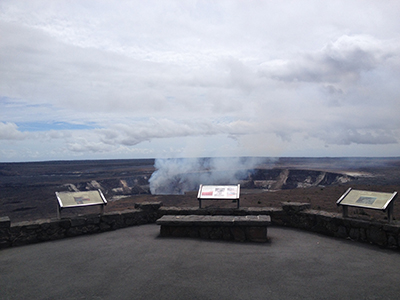
Government shutdown means lost revenue
This fall, at a time when most U.S. national parks would be bustling with guests, they were instead deserted.
Because of budget disagreements within Congress, the federal government shut down on Oct. 1, 2013. For the next 16 days, this affected not only the Senate and the House of Representatives, but also all other aspects of the government, including the operation of our national parks.
| Click on the video at the right to view an audio slideshow about the impact of the government shutdown at Acadia National Park in Maine prepared by writer Marissa Young. |
The Antideficiency Act prohibits federal employees from using funds that have not been appropriated to them. In other words, the country’s 401 national parks could not remain open during the shutdown.
“It certainly was a difficult time for us,” said Valerie Gohlke, a public affairs specialist at Carlsbad Caverns National Park in New Mexico.
“For those of us who have chosen being a park ranger as a career it is … what we love to do and [we] want to be able to do our job…. All we wanted to do was go back to work.”
| At right, road crew members stand around a barricade at Denali National Park, Alaska (Photo courtesy of National Park Service). Below, a park ranger welcomes one of the first visitors to Glacier National Park, Montana, after the shutdown (Photo courtesy of Glacier National Park). |  |
During the shutdown, all non-essential government employees, including most park rangers, were furloughed. The rangers who did work were there to ensure health and safety or to prevent visitors from entering the parks.
 “The rangers left on duty had a very difficult time having to turn people away from the park, when their normal role is to welcome visitors,” said Wanda Moran, a ranger at Acadia National Park in Maine. “One ranger said it was the hardest thing he’d ever had to do.”
“The rangers left on duty had a very difficult time having to turn people away from the park, when their normal role is to welcome visitors,” said Wanda Moran, a ranger at Acadia National Park in Maine. “One ranger said it was the hardest thing he’d ever had to do.”
Denise Germann, a management assistant at Glacier National Park in Montana, agreed.
“The government shutdown was challenging… [because employees] are here to care for the park and all the spectacular resources within [it]…, not maintain a closure of the park,” she said.
Would-be guests were also unhappy with the park closures. Some chose to physically express this outrage.
“We had two small instances of graffiti on our gates, but other than that, visitors we talked to were just disappointed,” said Gohlke.
The shutdown significantly impaired the majority of the parks, especially since it occurred at the peak of the fall season, when the leaves are changing colors in most states. Often, visitors plan trips specifically to see this.
This means that during the shutdown, parks lost thousands of dollars or more in entrance fees.
| At right, costs of operating a national park are considerable, as this poster about the Blue Ridge Parkway indicates (Graphic courtesy of National Parks Conservation Association). Below, the Jaggar Museum Observation Deck at Kilauea Volcano’s Halemaumau Crater, Hawai’i Volcanoes National Park, which is usually packed with hundreds of guests, was empty (Photo courtesy of National Park Service/J. Ferracane). |  |
Blue Ridge Parkway in North Carolina and Virginia gets 60,000 guests each day in October, more than any other national park. It collects $1.4 million in fees per day.
Using this statistic, one can calculate that a 16-day shutdown would result in a loss of $22.4 million in fees alone.
Concessions within the parks suffered as well. For example, the Jordan Pond House Restaurant at Acadia lost tens of thousands of dollars’ worth of business.
The losses did not stop at park boundaries. Transportation services and other local businesses were affected by the lack of visitors to the parks and, therefore, to nearby towns.
“[Acadia shares] Mount Desert Island with several small towns,” said Moran about the areas surrounding her park.
 “Business in those towns was down because visitors didn’t come to stay at the hotels and eat in the restaurants.“
“Business in those towns was down because visitors didn’t come to stay at the hotels and eat in the restaurants.“
Some parks did not suffer as much as others financially.
“[The] shutdown came at a time of the year when Denali visitors were not severely impacted,” explained Kris Fister, a public affairs officer at Denali National Park and Preserve in Alaska.
Because the majority of people visit Alaska from late spring to the end of the summer, most of Denali’s visitor facilities and nearby businesses close by mid-September.
“I am certain that there [were] some off-season visitors who had planned to stop in and travel the park road… but it would have been a very small number of people,” Fister said. “The handful of lodgings and restaurants that stay open in the nearby communities… would have been minimally impacted.”
Even so, the shutdown affected the park workers.
“The shutdown shortened the season for some seasonal employees… and prevented permanent employees from doing work that takes place after our main visitor season, [like] working on end-of-year reports, finishing up projects prior to winter weather coming in, working on contracts for next year [and] entering data,” Fister said.
Yukon-Charley Rivers National Preserve, also located in Alaska, did not have financial setbacks either.
“[It] is sort of an anomaly in the system, as it is a preserve where hunting, fishing, trapping and recreating are allowed and the unit itself was not closed and was utilized by visitors,” explained Pat Sanders, lead interpretive ranger/community liaison/area coordinator at the preserve.
However, the preserve still could not escape the shutdown’s negative effects.
“The shutdown did indeed cause us great concern because we had no way to monitor use or keep track of users and their safety,” said Sanders.
The fact that the shutdown happened during an active hunting season added more stress for the preserve’s small staff, which maintains 2.5 million acres of land.
| The MacFarlane family of Scotland were the first visitors to enter Hawai’i Volcanoes National Park once it reopened (Photo courtesy of National Park Service/J. Ferracane).
|
 |
Some parks, like Mount Rushmore National Memorial in South Dakota and Great Smoky Mountains National Park in Tennessee and North Carolina, were lucky enough to receive funding from state governments.
Thanks to these donations, these parks were able to resume operation before the end of the shutdown.
“We were all happy to be back to work,” said Maureen McGee-Ballinger, chief of interpretation and education at Mount Rushmore.
Most other parks were not as fortunate.
They had to wait to reopen until the government compromised on a budget and the shutdown ended on Oct. 16.
At Carlsbad Caverns, “there were no long term effects, and we are back to business as usual, hoping another shutdown does not happen in January,” said Gohlke.
Even with the government operating once again, it is important to remember that our national parks are still in need of increased funding and must be the focus of government budget discussions.
Quick Facts About the Government Shutdown
- Oct. 1-16, 2013 (16 days).
- Resulted in closure of national parks.
- Park employees were out of work.
- Many parks suffered huge economic losses.

Comments are Closed